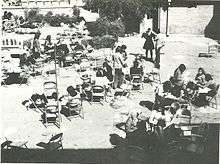Iran Bethel School

Iran Bethel School (1874 ~ 1968) was established as an American missionary organization for women in Tehran in 1874.[1] Annie Woodman Stocking Boyce- born in Wiscasset, Maine, on 7 January 1880, worked as a Presbyterian missionary in Iran from 1906 until her retirement in 1949. She was assigned to teach in Iran Bethel School for girls. During her first year in Tehran she led morning chapel for the Persian speaking group [in Iran Bethel School]…. Taught Bible to all grades in Persian.. taught a great variety of subjects in English. In 1918 she became the President of the Alumnae Association of Iran Bethel School. And she began to use this organization as a forum for transforming Iranian women lives.
Jane Doolittle who came to Iran in 1919 as a biology teacher,[2][3] became its principal in 1925. The history of Iran Bethel School has been along with ups and downs while some of the most significant women have been graduated from this school. Parvin E'tesami, the well known Iranian poet was graduated from this School. She studied at the American Girls College in Tehran, graduated in 1924 from the Iran Bethel, an American high school for girls. Afterwards, she taught for a while at that school.[4]
Origin of the title
Bethel is mentioned in over sixty verses in the Bible, representing over thirty distinct stories and prophecies, all of them in the Old Testament.[5] It is an ancient town in the West Bank, near Jerusalem: in the Old Testament, the place where the dream of Jacob occurred (Genesis 28:19). It is also a chapel of any of certain Nonconformist Christian sects.[6]
History
Who was Anna Khanum?[7] Little is known about the Iranian lady who opened her home one hundred two years ago to twelve small girls desiring an elementary education.[8] Early Journals show that the home was near Qazvin Gate which was in the West section of Tehran, and the date was April, 1874.[9] The school had some success, and the following year Presbyterian missionaries from the United States rented property at the southern end of Lalezar street which was a central area of Tehran, so the student population would have room to grow.
The Presbyterian Mission Station records the purchase of property to be used for a Church and schools on Qavam e Saltaneh on February 11, 1886. The Name "Iran Bethel" was formally approved in 1889. Crimson was chosen for the school color in 1891, and the motto was "That thy daughters may be as cornerstones, hewn after the fashion of a palace".[10]
A landmark year was 1921 which brought a unique young American missionary, Jane Doolittle, whose commitment and dedication to Iran would guide the school through the better part of half century. In February, 1949, the property at 27 Diba Street was purchased.
The American schools's encouraging results on the small Diba campus led the new president, Dr. Frances M. Gray, to consider the formulation of plans for a new campus to meet the growing needs. Two years after she became president of the college, the school was authorized to open as a MADRESEH ALI in 1968. Officially designated as DANESHKADEH in 1974, with approval and accreditation of a full four-year course leading to a B.A. degree in English Literature.[11] Its new name Damavand College was after the name of the highest Mount of Iran, Mount Damavand. Damavand College offered a four year intercultural program in the liberal arts.[12]
The outcome
Without the Iran Bethel school and the efforts of Jane Doolittle and Frances M. Gray, Damavand College could have never been established and the improvement of the early deprived Iranian women of Qajar and later Pahlavi dynasty could have never been achieved.
References
- ↑ Woman, Religion and Culture in Iran- Sarah F.D. Ansari, Vanessa Martin- p. 54
- ↑ "Global Prayer Digest". globalprayerdigest.org.
- ↑ Biography, Jane Doolittle by AL
- ↑ Parvin E'tesami
- ↑ "What is the History and Importance of Bethel in the Bible?". Spiritual Insights for Everyday Life.
- ↑ "Bethel". TheFreeDictionary.com.
- ↑ Abbas II of Persia#cite note-3
- ↑ Damavand College Year Book of 1976~77, p. 7
- ↑ Mozaffar ad-Din Shah Qajar
- ↑ Damavand College Year Book, 1976-77, p.7, second Paragraph, line 5
- ↑ Heights 1976 ~ 77, Damavand College, p.7
- ↑ Heights 1975-76, Damavand College, p.5
- Heights 1975~76, Damavand College
- Heights 1976~77, Damavand College